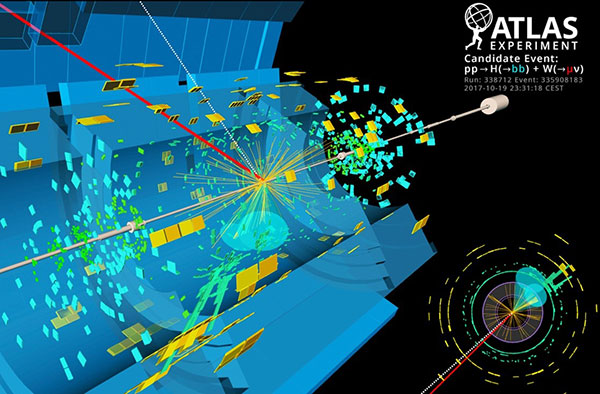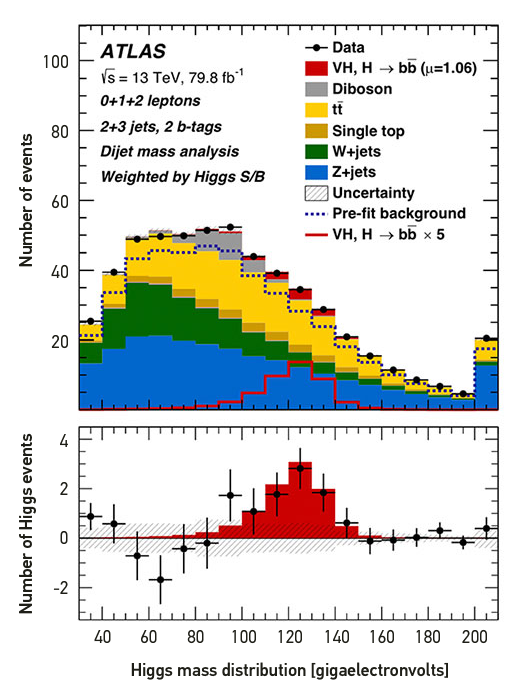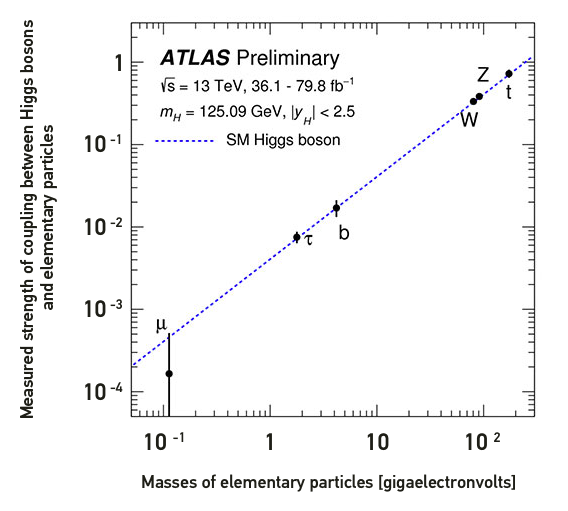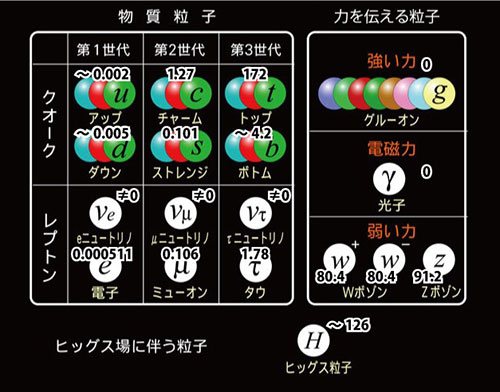Professor Shoji Asai (Director, ICEPP, The University of Tokyo / Professor in the Department of Physics, Graduate School of Science, The University of Tokyo)
Professor Kazunori Hanagaki (Institute of Particle and Nuclear Studies, KEK)
Assistant Professor Tatsuya Masubuchi (ICEPP, The University of Tokyo)
ATLAS Japan Group (Note 1)
Key points
- * The decay of a Higgs boson into bottom quark pairs, signal events that heretofore has not been observed experimentally, was observed with a significance of more than 5 standard derivations.
- The Higgs boson coupling with bottom quarks (Note 2), top quarks (Note 3), and tau particles (Note 4) has been confirmed, and this result shows that mass in the particles that make up matter comes from a Higgs boson, a milestone in elementary particle research.
- This research suggests that the origin of generations (Note 5), which has been a major elementary particle research mystery, lies in differences in the strengths of Higgs boson couplings.

Overview
According to the Standard Model of elementary particles (Note 6), a Higgs boson should decay into bottom quarks with a fraction of 60%, making this the most dominantly generated signal. However, experimental observation is extremely difficult, so in the initial LHC-ATLAS experiment (Note 7) plan, observation was considered impossible.
In 2015, the collision energy of the LHC accelerator was doubled, and operation went even more smoothly than expected, enabling the collection of large amounts of data. Furthermore, new research utilising machine learning technology helped overcome the experimental difficulties, and the ATLAS Collaboration succeeded at observing a signal of a Higgs boson decaying into a pair of bottom quarks, with a significance of 5.4 standard deviations. At current detection sensitivity, it has also been determined that observation values match Standard Model predictions.
The results of the first experimental confirmation of the existence of the new interaction of Higgs boson-bottom quark coupling (Yukawa coupling) are a major milestone in fully elucidating the origin of the mass of fermions, elementary particles that make up matter, and of the Higgs mechanism (Note 8).
Given the results of previous research, discussed in the background section below, this discovery elucidates the reactions between all third-generation fermions and Higgs bosons, as well as the mechanism by which these interactions produce mass. As Figure 3 shows, the experiment found, within a range of uncertainty, that both the elementary particles that make up matter and the elementary particles that convey force acquire mass through the Higgs mechanism. The elucidation of the origin of matter is the experiment's second turning point, following the discovery of the Higgs boson.
In the future, researchers aim to observe the coupling of second-generation fermions, and are working to solve one of the great mysteries of elementary particle physics, particle generations. They are also increasing the precision of their measurements of observed coupling strengths and searching for derivation from the Standard Model.
Contents of announcement
On August 28, at 10:30 p.m. (local time), the European Organization for Nuclear Research (CERN) issued a press release regarding the results of an experiment conducted at the Large Hadron Collider (LHC). In Japan, following CERN's announcement, the University of Tokyo and High Energy Accelerator Research Organization (KEK), key members of the ATLAS Japan Group that performed experimentation in LHC, also provided information regarding the experiment.
The title of CERN's press release was "Long-sought decay of a Higgs boson observed - Six years after its discovery, the Higgs boson has at last been observed decaying to fundamental particles known as bottom quarks".
Background
The LHC, the world's highest energy particle collider, is a circular accelerator that collides protons. Since the discovery of the Higgs boson on July 4, 2012, its collision energy has been increased to 13 TeV (teraelectronvolt), and it has performed precision measurement of interactions between a Higgs boson and elementary particles. During the first phase, which began in 2009, the Higgs boson was discovered, and coupling between the elementary particles that convey force (W and Z particles) and the Higgs boson were measured, answering the question of the origin of the mass of elementary particles that convey force.
In the second phase, which began in 2015, the ATLAS Experiment Group has observed evidence of Higgs bosons coupling with top quarks and tau particles, which are both third-generation fermions (elementary particles that make up matter).
Research contents and results
Data collected until 2017 was analysed and, for the first time ever, the decay of a Higgs boson into a pair of bottom quarks was observed, with a 5.4 sigma confidence level (Figure 1). The (branching) fraction of Higgs bosons decaying into bottom quark pairs is 60%, far greater than that of those decaying into other charged leptons, W particle pairs, Z particle pairs, or photon pairs, which have already been observed. However, experimental observation is difficult (because of the large amount of background "noise" shown in the top graph of Figure 2), so both the ATLAS and CMS experiment groups have attempted to observe it for the first time ever with the LHC.
The large amount of data from the second phase of the LHC experiment and advances in machine learning and other analysis technologies made it possible to increase the detection sensitivity, helping make it possible to observe this phenomenon for the first time ever. The bottom graph in Figure 2 shows the distribution of the masses of decayed parent particles of bottom quark pairs. The distribution (crosses) of measurements after expected background was removed from the observation data matched the signals predicted for Higgs bosons by the Standard Model (red histogram: figures predicted by the Standard Model multiplied by 1.06). As this figure shows, the decay of Higgs bosons into bottom quark pairs was significantly observed, and the yield of a Higgs boson is consistent with the prediction of the Standard Model within a range of uncertainty (20% accuracy).

Significance of this research and future potential
All interactions between third-generation fermions and Higgs bosons have been observed, so the origin of mass for third-generation fermions has been made clear. Coupling with elementary particles that convey force (W particles and Z particles) has already been observed during the first phase of experimentation. As Figure 3 shows, it has been demonstrated that both fermions, which make up matter, and the elementary particles that convey force gain their mass from the same Higgs mechanism. The horizontal axis of this figure is the elementary particle mass, and the vertical axis is the measured strength of coupling between the elementary particles and a Higgs boson. As the figure shows, all can be consistent with a single, straight line within a range of uncertainty. This indicates that the same Higgs mechanism provides these different types of elementary particles with their mass.
In the future, researchers aim to observe coupling with second-generation fermions. Coupling between the Higgs boson and muons, second-generation particles similar to electrons, has not yet been observed, and the upper limit value is close to double that predicted by the Standard Model. This value is smaller than 1/8 of that of the coupling between the Higgs boson and tau particles, third-generation particles similar to electrons, indicating that the strength of coupling with the Higgs boson differs significantly between generations. In other words, it suggests that the Higgs boson creates the different generations of elementary particles. Researchers will try to unravel one of the greatest mysteries of elementary particle physics, the existence of generations.
The measured coupling strengths, shown in Figure 3, can be described with a straight line, but there is still a sizable uncertainty. Many physics models that go beyond the Standard Model point out the possibility of interactions between the Higgs boson and bottom quarks deviating from the Standard Model. The current measurement accuracy is roughly 20%, but raising this further has high potential for enabling the discovery of signs of new physics. Higgs boson measurement has truly opened the gates of new physics.

Publications
Journal name:Physics Letters B
Title of paper:"Observation of H→bb ̄ decays and VH production with the ATLAS detector"
Authors:The ATLAS Collaboration
Abstract: (related site)
CERN announcement
●CERN Press Release, Long-sought decay of Higgs boson observed
●Comments from the ATLAS Collaboration:
ATLAS Press Statement, ATLAS observes elusive Higgs boson decay to a pair of bottom quarks
Terminology
- Note 1) ATLAS Japan Group: Composed of roughly 150 researchers (including graduate students) from the following 17 institutions: The University of Tokyo, High Energy Accelerator Research Organization, University of Tsukuba, Ochanomizu University, Waseda University, Tokyo Institute of Technology, Tokyo Metropolitan University, Shinshu University, Nagoya University, Kyoto University, Kyoto University of Education, Osaka University, Kobe University, Okayama University, Hiroshima Institute of Technology, Kyushu University, and Nagasaki Institute of Applied Science.
- Note 2) Bottom quark: The bottom quark is an elementary particle that is partnered with the top quark. It is the second-heaviest elementary particle that makes up matter, following the top quark. The properties of these particles are being studied in depth through the Belle II experiment at the SuperKEKB accelerator.
- Note 3) Top quark: The top quark is the heaviest elementary particle that has been discovered to date. It is known to be heavier than the Higgs boson.
- Note 4) Tau particle: The tau particle is a heavy third-generation elementary particle, alongside the top and the bottom quark, and has the same properties as the electron.
- Note 5) Elementary particle generations: As Figure 4 shows, within the elementary particles that make up matter, the electron, the electron neutrino, the up quark, and the down quark make up a set. This set is called a generation, and experiments have shown that there are three generations. Kobayashi and Masukawa predicted the existence of the third generation, for which they were awarded the Nobel Prize in Physics in 2008. Except for mass, elementary particles in different generations have the same properties, so one of the great mysteries of elementary particles is why there are different generations, and why there are three generations.
- Note 6) Elementary particles: Elementary particles are the smallest, indivisible units that make up existence. They are categorized into the smallest particles that make up matter, particles that convey force, and a Higgs bosons. There exist three generations of particles that make up matter, which all share similar properties. The amount of mass differs depending on the type of particle. For example, the top quark has roughly 300,000 times the mass of the electron.
- Note 7) ATLAS Experiment: The ATLAS experiment is an experiment conducted using the ATLAS detector installed in CERN's LHC, on the border of France and Switzerland. It creates new particles with a high collision energy of 13 to 14TeV, and its goal is to reveal the mysteries of the early universe. The ATLAS experiment is a joint project by CERN member countries. Initial investment alone for the LHC and its detector ran roughly 500 billion yen. Japan is an observer country, but also bore part of the construction expenses and has collaborated in the manufacture of accelerators and experimental equipment, data analysis, research, and more. The ATLAS experiment, in which Japan is participating, uses a massive detector capable of detecting the decay of new particles produced by collisions. In the summer of 2012, it announced that, together with results from the LHC's CMS detector, it had discovered a signal believed to be from the Higgs boson. This was tremendous news around the world.
- Note 8) Higgs mechanism: Elementary particles are not believed to initially have mass, but gain mass through interaction with the Higgs field by what is called the Higgs mechanism. Higgs fields are known to permeate the entire universe we live in. This means that even vacuums are not completely empty space. Immediately following the birth of the universe, the properties of the Higgs field changed dramatically, and these dynamic changes created mass for elementary particles.

